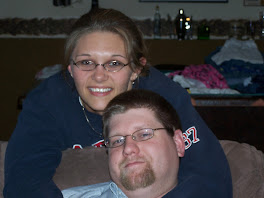The next couple of visits were nothing more than checking Doppler tones of the two fetuses and standard testing. Not very exciting reading, I know, but we did get scheduled for a Level II Ultrasound in Minneapolis at 19 weeks. This would be the first time we got see the babies since the first ultrasound at nine weeks. We did have a choice of which hospital to have this ultrasound done at, but if there were any complications we would more than likely be sent to Minneapolis. Sam and I thought it would be nice to become familiar with the hospital in case something should happen.
Our Level II exam started very well. We were pleased to hear that were having boys. The technician was encouraged by the size and the Doppler tones of Baby B. As he progressed through to Baby A he became very quiet and went about the exam. He concluded the exam and stated that the doctor would be in very shortly to speak with us. 30 minutes later, a doctor appeared and informed us that he thought our twins had the signs of Twin-to-Twin Transfusion Syndrome (TTTS). He explained what the syndrome was and if it was truly the case what our options would be. Our options were do nothing and wait an see what transpires, do serial amniocentesis, or have an experimental laser surgery to try to fix this condition. Now remember we are only at 19 weeks at this point and it is rare to be diagnosed this early. We knew we were having twins and that this is a disease that does affect twins, so we knew a little about it, but it only affects about 10% off identical twins, so it was more or less dismissed in our readings. The doctor was not ready to diagnose that this syndrome is actually present, so he asked us to come back the following day to follow up with a doctor who is more familiar with these types of cases. We were sent on our way with our heads spinning.
That night my wife and I did a lot of research on this syndrome and thanks to some great websites we learned that there were options and the risks with those options. Twin to Twin Transfusion Syndrome is an abnormality that causes an uneven flow of blood between two babies of an identical twin pregnancy through blood vessels that are present in the common placenta, resulting in a larger baby and a smaller baby. This occurs in about 10-15% of identical twin pregnancies for unknown reasons. (See links to the left).
The next morning we got our kids off to school, loaded up "The Minivan" with a small overnight bag for Sam just in case, and headed back to the cities not knowing what might become of our visit. This trip for us to the hospital is about an hour and a half each way, but it seems much farther when you are not sure what to expect. We met with a doctor who has extensively studied TTTS. He informed us that the fluid level in baby A (the donor baby) was 1.75cm and baby B (the recipient) was over 9cm, and that baby B was starting to show signs of heart distress. Baby A was also more than 15% smaller than baby B, and our stage of TTTS was estimated to be a 3. The Dr. went through our options again with more details, and gave us some percentages of survival rates of each option. We both quickly decided that our best option would be to have the Selective Laser Ablation surgery here in MN the very next day as we felt the urgency was necessary. Sam was then admitted to the hospital to be put on antibiotics before the surgery the next day.




